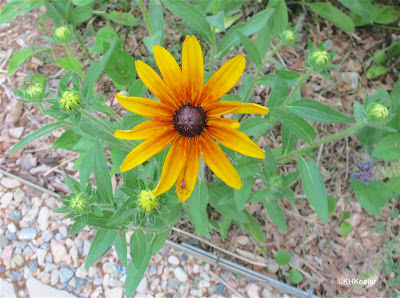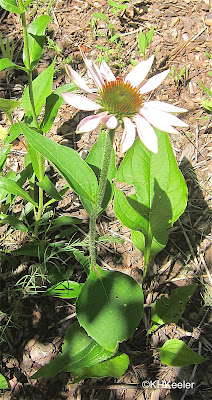 |
| coneflower |
If you are confused when someone points out a coneflower and it is not what you expected, you are not alone. I count forty different plant species in five genera that are called coneflower. Some you will probably never encounter, but three genera, Echinacea, Rudbeckia, and Ratibida, are relatively common and sold as garden flowers. I'll start with those.
The one that comes up when I google "coneflower" is Echinacea. The echinaceas* are handsome members of the sunflower family, Asteraceae. There are nine species, all native to North America. They are also called purple coneflowers, since all but one species have reddish flowers, the shades ranging from intensely pink-purple to very pale. The last species, Echinacea paradoxica, has yellow flowers and is called yellow coneflower (not yellow purple coneflower). I don't have a photo of it but it is very like other Echinacea species except for color. None of the purple echinaceas appear to have common names other than purple coneflower (smooth purple coneflower, eastern purple coneflower etc.), except Echinacea angustifolia which is known as black samson, although sometimes you see narrow-leaf echinacea.
(*You cannot put an s on a scientific name, Latin doesn't do that. For this post I'm going to turn scientific names into common names, so dropping the capital letter and italics, and allowing an s to make a plural--because the point of the post is that all the plants have the same usual common name. The scientific names distinguish the plants as the common names don't., especially for these plants. )
 |
| purple coneflower, Echinacea, probably E. purpurea |
 |
| pale coneflower, Echinacea pallida |
Also called coneflowers are plants in the genus Rudbeckia, sunflower family, Asteraceae. There are 23 species of Rudbeckia, all native to North America. Common names include orange coneflower (Rudbeckia fulgida), tall coneflower (R. grandiflora), western coneflower (R. occidentalis), etc.
 |
| coneflowers, Rudbeckia |
 |
| coneflowers, black-eyed Susans, Rudbeckia |
A pair of common name that the rudbeckias have to themselves are black-eyed Susan and brown-eyed Susan. I only found a few species for which these common names were used though. The black-eyed Susans are black-eyed Susan or common black-eyed Susan Rudbeckia hirta, perennial black-eyed Susan, Rudbeckia fulgida, and sweet black-eyed Susan R. subtomentosa. Brown-eyed Susan is a distinct common name for three more rudbeckias, brown-eyed Susan (R. triloba), giant brown-eyed Susan (Rudbeckia maxima), and bog brown-eyed Susan (R. scabrifolia). The common and well-known Rudbeckia hirta is called brown-eyed Susan as well as black-eyed Susan The other 16 species of Rudbeckia share the common name coneflower with the purple coneflowers, Echinacea.
The third major group of species called coneflowers are the prairie coneflowers, genus Ratibida, sunflower family, Asteraceae. There are seven species of Ratibida, native to North America, four of which grow north of Mexico. This is the plant I think of as the coneflower because the flower head shape reminds me strongly of a cone. They are regularly called prairie coneflowers, which distinguishes them from the others except for Rudbeckia fulgida, aka perennial black-eyed Susan, which is also called prairie coneflower.
 |
| prairie coneflower, Ratibida pinnata |
 |
| prairie coneflower, Ratibida columnifera |
Ratibida pinnata, native across the eastern half of North America, has yellow petals and is called yellow coneflower (same as Echinacea paradoxica), but also pinnate prairie coneflower, grayhead coneflower and gray-head Mexican hat.
Mexican hat is an alternate common name for the ratibidas. Neither of my photos captures it, but the name comes Ratibida columnifera, called upright prairie coneflower by the USDA website, which has petals that range from yellow to purplish to red often mixed on the same petal, making the similarity to a droopy big hat clearer (link). This species has a native range across almost all North America (link).
So you see, three different native American wildflowers in the sunflower family are called coneflowers. If you are careful to say purple coneflower or prairie coneflower, it helps, but dropping those modifiers is common.
There are two other genera called coneflowers. One is Dracopis, the clasping coneflower, which contains just one species, Dracopis amplexicaulis. It has recently been separated from Rudbeckia, so the coneflower name is logical (about clasping coneflower).
The other is the genus Isopogon, in the plant family Proteaceae. The Proteaceae is entirely native to the Southern Hemisphere and does not occur in North America. Most of these native Australian wildflowers are called drumsticks or have particular common names that don't include coneflower, but I counted six that were called coneflowers (Isopogon adenanthoides, spider coneflower; I. alcornis, elkhorn cornflower; I. formosus, rose coneflower; I. polycephalus, clustered coneflower; I. teretifolius nodding coneflower, and I. trilobus barrel coneflower). There are many differences between Australian English and American English, so it is not a surprise for Australians to have their own coneflowers. (See Isopogon). But be aware that an internet search on "coneflower" can bring up the Australian plants.
The American coneflowers are very pretty and much-cultivated. The confusion of coneflowers has no simple solution. If you want a particular one, learn its scientific name and ask for the scientific name before buying the "coneflower."
 |
| All the coneflowers are attractive to bees and butterflies |
 |
| Two coneflowers, Rudbeckia and Ratibida, in a Colorado grassland |
Comments and corrections welcome.
References
Articles on Echinacea, Ratibida, and Rudbeckia in the Flora of North America link Accessed 8/10/20 to 8/13/20.
Lady Bird Johnson Wildflower Center https://www.wildflower.org link Accessed 8/10/20. Good source
of common names.
USDA plants data base, Echinacea, Ratibida and Rudbeckia link Accessed 8/10.20
they are all beautiful when in full bloom
ReplyDelete